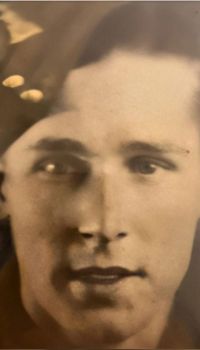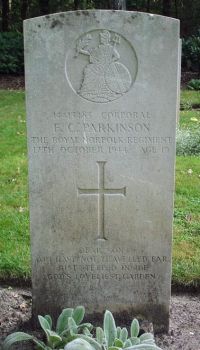Parkinson | Francis Clifford
- First names
Francis Clifford
- Age
19
- Date of birth
1925
- Date of death
17-10-1944
- Service number
14413483
- Rank
Corporal
- Regiment
Royal Norfolk Regiment, 1st Bn.
- Grave number
III. B. 1.


Biography
Francis Clifford Parkinson (Service No.14413483 ) was killed in action on 17 October 1944 between Overloon and Venray. He was aged 19 and a Corporal in the 1st Battalion of the Royal Norfolk Regiment. He was initially buried at Cemetery Venraysweg in Overloon. He was re-interred on 14 May 1947 in Grave III. B. 1 at the CWGC Cemetery in Overloon. His inscription reads “Dear son you have not travelled far, just stepped inside God’s loveliest garden.”
Military Career
It isn’t known when Francis Clifford Parkinson joined up in the 1st Battalion of the Royal Norfolk Regiment though given his age, it is likely to have been in 1943.
The 1st Battalion of the Royal Norfolk Regiment was still in India on the outbreak of the Second World War. It remained there until July 1940, when it returned home. It then spent the next few years training in Scotland and elsewhere in preparation for what was to come.
It landed in Normandy at Sword Beach on D-Day (6 June 1944). It played its part in the 1st and 2nd Battles for Caen which succeeded on 9 July after which the Battalion had its first rest period since D-Day. It continued the fight in Normandy through mid July and early August and was involved with Operation Goodwood and then in the preparation for the break out from Normandy which succeeded in late August.
From 17 August until 3 September the Battalion had a rest period which also allowed them to take on reinforcements to replace the substantial number of men they had lost. It then moved to Villers en Vexin until 17 September.
By this time, the Allied troops were making a fast advance through France and Belgium to the Escaut canal south of Eindhoven in readiness for Operation Market Garden. On 17 September, airborne troops landed in a corridor from the Belgian/Dutch border via Eindhoven and Nijmegen to Arnhem to secure bridges and allow ground forces to move forward with speed – then to reinforce and strike east into Germany.
The role of the Battalion along with others was to protect the main line of communications northwards along this corridor. It moved on from Villers en Vexin on 18 September and reached Peer on 19 September then Asten on 23 September. They entered Helmond, just east of Eindhoven, on 25 September. It had just been taken by another Battalion and they received an uproarious welcome from the Dutch people.
On 29 September, it moved out of Helmond and on over the River Maas at Grave through Heumen and on to Maldens Vlak. Here they spent time patrolling the area facing the Reichswald Forest in Germany not far to the east. On 9 October the Battalion retraced its steps to Grave, then south to dominate a stretch of the River Maas in the Cuijk area.
However, problems with supply lines had resulted in the failure of the Allies to hold the bridge at Arnhem, so plans changed. The Allies found themselves in a narrow salient through the Netherlands and so it was decided to clear the enemy to the south in Overloon, Venray and Venlo while also securing Antwerp to help with supply issues. American Troops initially attempted to take Overloon, but did not succeed so the British Army took on the task.
On 11 October, the Battalion therefore moved on foot from Cuijk through Haps and St Hubert and on again the next day to Wanroij, St Anthonis and Oploo, arriving north of Overloon on 13 October. At this time, other British Troops were engaged in capturing Overloon, using an artillery barrage which caused heavy damage to the village.
The Battalion spent the night of 13 October in the woods around Overloon. The ground forward of the woods was flat and featureless and about midway between Overloon and Venray ran a stream called the Molenbeek. From its far bank the enemy had a clear view over a distance of 1000 yards of the British Troops leaving the shelter of the woods.
At 0700 hrs on the morning of 14 October, two companies led the attack to the south with support from two troops of Churchill tanks. The advance was a difficult one, as once through the thick woods there was very little cover. Some tanks were hit and others retreated back into the woods, leaving the Infantry without support. The Battalion succeeded in reaching a point about 400 yds short of the Molenbeek that day, though were left in a very exposed position. They had to remain there the following day while other units reached their positions in order to carry out a co-ordinated attack on the Molenbeek the following day.
The Molenbeek was between 10 and 15 feet wide and had slopping banks about 5 feet high creating an effective gap of about 30 feet. The approaches were difficult with cratered tracks and waterlogged ground. The area was extensively mined. The success of the operation depended on crossing the beek silently by night. Any attempt by day would be suicidal as the road bridge was blown. It was therefore planned that the infantry would cross using floating pontoon bridges while a bridging tank would use a girder bridge for vehicles, including tanks.
The Royal Engineers successfully built the two pontoon bridges overnight – one on each side of the road. At 0500 hrs on 16 October B and D Companies crossed without incident – though it was later discovered that D Company had walked through a minefield of Schumines. Later A Coy did the same with no casualties. By 0600 hrs the leading Companies were keen to press on as they were lying in the open in full view of the enemy and getting casualties. However, other units hadn’t fared as well and so the Norfolks weren’t allowed to push on. The bridging tank failed to lay the bridge under intense fire. On the second attempt a flail tank was half way across when the whole lot toppled into the Beek. The Battalion’s Churchill tanks had all been knocked out – but thankfully the enemy tanks had withdrawn. By 0700 hrs the leading companies were allowed to progress. Casualties mounted up. By the afternoon, A and C Companies were able to push on to about 1000 yds south of the Molenbeek. The Battalion had succeeded in securing the crossing and forcing the enemy to withdraw. Seventeen men of the Battalion were killed on this day.
The Battalion had a less tough time the following day as the bridge had been completed sufficiently to allow some vehicles over and physical contact with the enemy had finished – but they still had to endure shell, mortar and “Moaning Minnie” fire. However, Francis Clifford Parkinson was killed on this day, having survived the horrors of the day before.
By 18 October Venray had been taken. Between 13 and 18 October, the Battalion incurred 43 fatal casualties and about 200 wounded.
Family Background
Francis Clifford Parkinson was the son of Frank and Helena Parkinson of Surbiton, Surrey.
Francis Parkinson had married Helena Coyle in 1924 in Kingston, Surrey.
Little more is known of Francis Snr’s background except that he was born on 1/11/1900.
Helena Coyle was born on 7/9/1905 at Walworth, Surrey. She was the daughter of Daisy Eleanor Coyle but no father’s name was given. Daisy, who was born in 1885, was the daughter of James and Mary Coyle. She and her twin sister, Hettie Rose Coyle, were two of twelve children born between 1880 and 1900 in Southwark.
In 1901 Daisy was living with her parents and eight of her siblings at 8, Otto Street, Newington, St Saviour, Southwark. Twins Daisy and Hettie were working as Ironers. Daisy was still at the same address in 1911, but her mother, Mary, was now a widow. Daisy was still working as an Ironer. Her daughter Helena was with her. There too were three of Mary’s other children.
Daisy’s twin sister, Hettie, married William James Covill in 1910 in Kingston, Surrey then Daisy herself (shown as Daisy H – so possible Daisy Helena) went on to marry Ernest E Covill in 1913, again in Kingston. Ernest had been born in 1886 in Bexley, Kent.
It seems that both William and Ernest Covill served in WW1. William was a Lance Corporal in the East Surrey Regiment (Service Nos. 2811, 31098). Ernest was initially a private in the same Regiment (L/9028) but was transferred to the East Kent Regiment on 4/9/1916 (L/809, L/11016).
In June 1921, Ernest and Daisy Covill were living at 1, Spring Cottages, Kingston upon Thames, Surrey. Ernest was a self employed jobbing gardener. They had four children with them: Nellie (presumably Helena) who was working as a Laundry Maid for the Royal Thame Laundry at Kingston on Thames, Sidney E L b 1914, Doris b 7/4/1917 and Irene b 1920.
Daisy’s mother, Mary J Coyle was living nearby at 3 Spring Cottages. With her was her son, Edward R Coyle, who was working as a Motor Driver for Gaydons & Son Jewellers, but also two granddaughters, Ivy Gladys Covill b 13/8/1910 and Florence V Covill b 1915, both born in Kingston who seem to have been Hettie and William’s children. It is possible that Hettie and William Covill had separated.
Ernest Covill died in 1927, so by September 1939, Daisy Covill was widowed and living at 104 Mount Pleasant Road, New Malden, Surrey. She was working as a school cleaner. Living with her was her daughter Doris but also three other Covill children who had been born after June 1921: Lillian E b 18/11/1921, William b 5/2/1923 and Evelyn R b 28/1/1924. Doris was working at the Glad Iron Laundry, Lillian as a Packer/Sorter at a Laundry and William as a Steelwork Labourer. Present too was Frederick Hoy born 15/12/1917 who was a Machinist at a Steelworks. It was indicated that Doris later married someone called Goodbody. Another Covill child, Stanley, had been born in 1921 but died the same year. Lillian, Stanley and Evelyn were all born in Kingston.
After their marriage in 1924, Francis and Helena Parkinson had children as follows: Francis Clifford 1925, Avis M 1929 and Brian J 2/6/1931. Francis and Avis were born in Kingston while Brian was born in Surbiton. At Brian’s birth, Helena gave her maiden name as Covill rather than Coyle.
In 1939 Frank and Helena were living at 25 Addison Gardens, Surbiton. With them were 2 children who were not named, presumably Francis and Avis, and also Brian who was named. Frank was working as a General Labourer.
Sadly, Francis Clifford Parkinson died near Overloon on 17/10/1944.
It is though that is father, Francis, died in 1961 in Surrey and his mother, Helena, in 1987 in Kingston upon Thames.
Sources and credits
From FindMyPast website: Civil and Parish Birth, Marriage and Death Records; England Census and 1939 Register Records; Electoral Rolls; Military Records
Information from “Thank God and the Infantry – from D-Day to VE-Day with the 1st Battalion, the Royal Norfolk Regiment” by John Lincoln
History of the 1st Battalion The Royal Norfolk Regiment
Wikipedia Royal Norfolk Regiment
Photo courtesy of David Parkinson (Francis’ nephew) and Hope Parkinson (Francis’ great niece).
Research Elaine Gathercole
